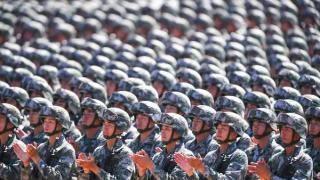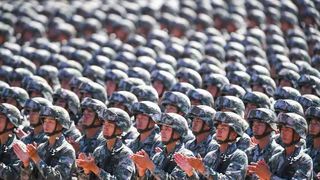Take with a large grain of salt the diplomatic denials that the 2020 Strategic Defence Update and commitment to spend $270bn on defence across the next decade is all about one country. There are other troubling developments in the region but only China’s coercive turn can account for the dramatic upgrade of our martial mindset, posture and capabilities.
That Beijing’s foreign ministry responded immediately in saying that all countries should avoid an arms race and refrain from purchasing unnecessary equipment is evidence it knows Canberra’s announcements last week is about China — which has caused some to question the Morrison government for poking the Chinese Communist Party in the eye when the bilateral relationship is deeply strained.

These are criticisms moved by a poor sense of history and strategy, and a poor understanding of the principles of negotiation and managing risk.
Since the early 1990s, the annual increase in spending on the People’s Liberation Army has been growing about twice as fast as the country’s gross domestic product and the increase in fiscal revenues collected by the regime. It has come to the point where China spends more on its military each year than the combined military outlays of all countries in East Asia, South Asia and Oceania — and the gap is widening. This is accompanied by a shift, which occurred two decades ago, from defending the homeland to developing offensive and power projection capabilities in the sea, air, cyber and space domains.
It has come to the point where China spends more on its military each year than the combined military outlays of all countries in East Asia, South Asia and Oceania — and the gap is widening.
For what purpose? By its own assessment made during the first decade of this century, the Chinese continent is unthreatened and the country is rising in the most stable external environment it has faced for several hundred years. Apparently hostile powers such as the US and its allies have played enormous roles in helping China succeed.
When Donald Rumsfeld, the US defence secretary at the time, dared to ask at the 2006 Shangri La Dialogue meeting why China was building its offensive military capabilities so rapidly and opaquely even as its diplomats assured the world its rise would be peaceful, he was pilloried for being provocative.
The point is that China has relentlessly pursued this course regardless of whether the US and others have pursued co-operative and trusting policies, or in more recent times, more confrontational measures. During the past decade, Beijing has used coercive military, economic and/or diplomatic measures against dozens of countries in Asia and Europe at its own whim and choosing. This coercive bent has accelerated since Xi Jinping assumed power in 2012. Remember that Beijing’s broken promises over the South China Sea preceded Donald Trump and occurred during Barack Obama’s more conciliatory presidency.
Besides, the recent record only reaffirms the folly of allowing China to dictate the nature or pace of escalation. For example, Beijing exacerbated matters in the border dispute with India in Ladakh and a maritime dispute with The Philippines in the past couple of months, even though New Delhi and Manila had just softened their policies towards China. It makes more sense to go ahead and do what is best for one’s interests without seeking permission and understanding from China. Beijing does not reward timidity.
This brings us to the Morrison government’s focus on adjusting to the increased likelihood of war, which includes investing in long-range and hypersonic missiles, unmanned and other weapons that will make it difficult for an enemy to establish dominance in a specific theatre of conflict, building offensive cyber capabilities and improving stockpiles and logistics to support and sustain any campaign.
Changing Beijing’s behaviour is possible only if we cause it to recalculate. Until recently, the CCP has been emboldened by realising that the harder it pushes, the more most countries tend to retreat. This must change.
Being prepared is the duty of any responsible government and a basic principle of good risk management. When considering that the US, Japan, India, Vietnam and others are moving in the same direction as Australia, there is also an important strategic shaping element to the government’s announcement.
The wicked problem is that China can and will do things that are out of the question for other countries; for example, illegally creating and militarising enormous artificial islands in disputed territory in the South China Sea. Beijing also has used national resources to gain influence in poor and easily corruptible countries to acquire an interest in or control civilian infrastructure that can be used later for military purposes.
Changing Beijing’s behaviour is possible only if we cause it to recalculate. Until recently, the CCP has been emboldened by realising that the harder it pushes, the more most countries tend to retreat. This must change.
In hard-power terms, countries need to convince the CCP that its encroaching military capabilities and assets and coercive behaviour are making itself less secure. This can be achieved only through Australia and other countries developing offensive weapons to inflict considerable if not prohibitive costs on China, and demonstrating the resolve to use these if required. It is why it is good that Beijing knows the countering measures being considered throughout the entire region are very much about China. When probing and meeting steel, all powers pause to reassess.
Finally, Canberra might be at the forefront of this undertaking, but Australia will not be alone. To calm those perennially hypersensitive about what our Southeast Asian neighbours think about us, there is quiet support for the announcements made by the Morrison government just as there is growing support for the Quad arrangement between the US, Japan, India and Australia.
Australia is not foolishly stumbling into a US-China rivalry but moving to shape the region to our liking and interests.






